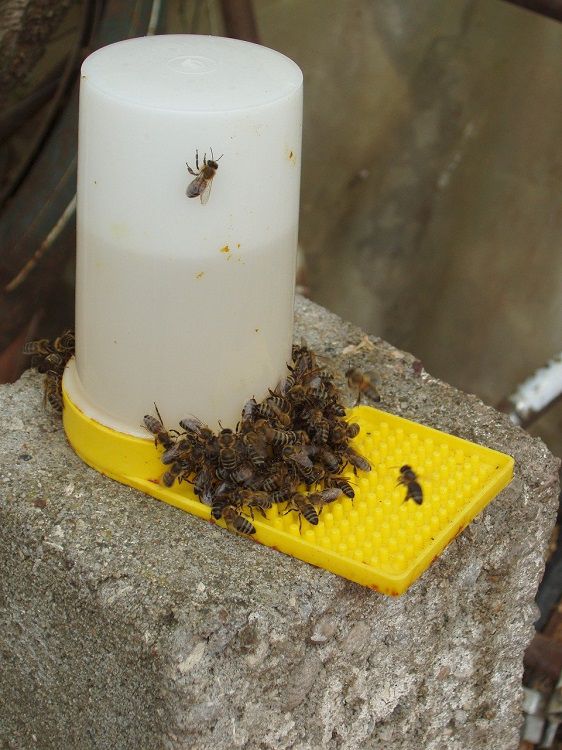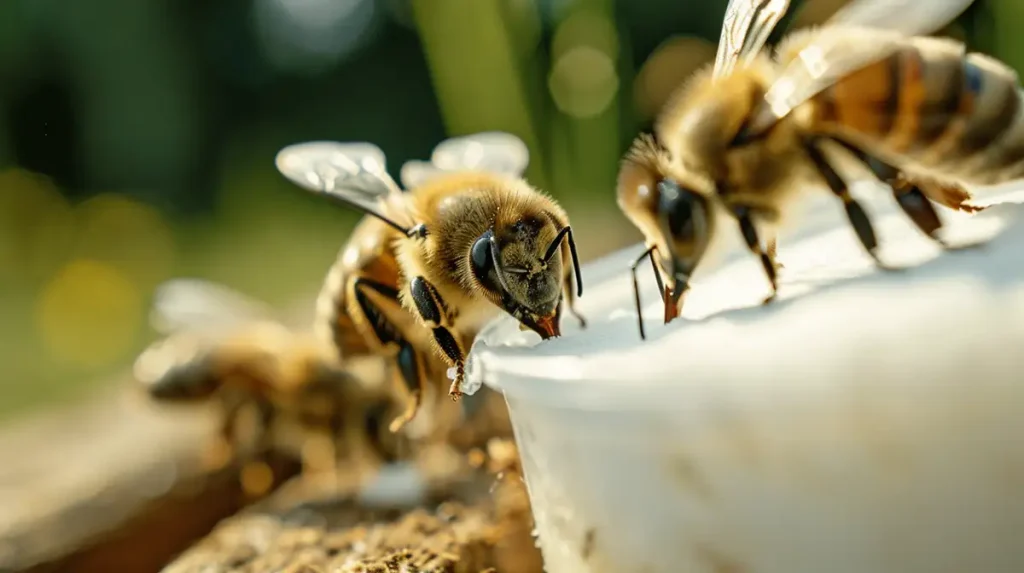Table of Contents
Bees typically prefer natural sources of nectar over sugar water due to the complex range of nutrients found in natural nectar that sugar water lacks. Nectar from flowers contains not just sucrose but also other essential nutrients and trace elements vital for a bee’s health. Sugar water, primarily made of sucrose and water, lacks these additional nutrients, making it less attractive and beneficial for bees. However, bees might consume sugar water if natural sources are scarce, but this is not ideal for their nutritional needs. This preference demonstrates bees’ innate ability to seek out the most nutritionally rich food sources available in their environment.
In the below paragraphs, we will take a more detailed look at this topic.
The energy of a hive, and with that its ability to complete all of the important tasks – from foraging to raising new bees and producing honey – ultimately comes from just two vital substances: pollen and nectar. Pollen is the powdery substance that contains the fertilizing male component of the next generation of plants. Worker bees collect this and feed it to larvae back at the hive. Nectar, on the other hand, is produced by plants in order to draw the bees (and other pollinators) in. It is a rich, sweet liquid – full of energy – that worker bees both consume on the spot and bring back to the hive for feeding purposes. It is from nectar that honey is produced – but it is also the substance which, more so than pollen, really keeps a hive going. Unfortunately, it is not always in abundant supply.
Bees cannot survive on pollen alone and, when nectar is in short supply, there comes times when it has to be replaced by beekeepers themselves. This is not only to prevent imminent starvation (as is occasionally a serious risk) but also to ensure sufficient stores of food for bees over the winter months when there is simply no means of retrieving any from plants.
Nectar, with its unique composition and honey-producing elements, of course cannot be recreated by beekeepers. However, the energy levels normally supplied by nectar can at least be matched by the sugar syrup, which is the stock-in-trade feeding substance used by beekeepers to keep the energy of a hive up when supplies of nectar are not readily forthcoming.
It might well come as pretty surprising then – especially when a colony is at risk of collapse or some other disaster – that bees will sometimes flatly reject the sugar syrup provided for them within the hive. This can be alarming for beekeepers, especially when the energy of a hive is critical. So why does this happen? In most cases, it comes down to atmospheric temperature above all else.
It is Just Too Cold
In the vast majority of cases, the reason bees will not accept the sugar syrup provided from a feeder is simply that it is too cold. What matters here, though, is the temperature of the syrup itself (although this is of course influenced by how cold it is). When its temperature drops to around 50F (10C), bees will simply reject it.
Depending on where you live, these temperature usually become common from the early fall onwards, so this can become a real problem for some beekeepers.
Nevertheless, even though the bees refusing to feed can be attributed in most cases to temperature, this does not mean that the situation is a simple case of “no feeding when it is too cold.” As mentioned, what matters is the temperature of the syrup itself. Bees do not refuse to feed because the cold makes them unable to; they refuse to feed because to consume the chilly syrup would cool them even further at a time when conservation of heat is essential for survival.

Keeping in mind therefore that it is the temperature of the syrup that matters, the situation can become more complicated. Why exactly is the syrup too cold? If you use an internal feeder (as is most commonly the case), the temperature of syrup is influenced not only by the outside atmospheric temperature, but also by the heat produced within the hive. This is a factor entirely controlled by the bees, with more active and larger colonies producing more heat.
Your syrup temperature problem could therefore be down to the size of your colony. There is an easy way to check this. If you find that one of your colonies isn’t feeding while the rest are, you can fairly reliably conclude that it is not only the outside temperature that is causing this. In such cases, it is highly likely that the colony refusing to feed is simply too small.
There does, of course, come a point when it is too cold for any colony to feed on artificially supplied sugar syrup. As we approach the winter months, the temperature is simply too low for even the largest colonies to keep sugar syrup warm enough for consumption. The trick then is to notice which of the hives ceases feeding first. If you can catch this, then you can start taking action to ensure the bees can build up food stores before it become too cold to add to them at all.
- Carter, Anthony (Author)
- English (Publication Language)
- 194 Pages - 02/28/2024 (Publication Date) - Independently published (Publisher)
What to Do About It?
If some of your hives are feeding while others are not, the size of the non-feeding hives is most likely the primary problem. The solution might then be to combine them. Combining hives is a common beekeeping solution that is applied in all manner of cases. It could be because of a poor nectar flow, a weak and irregularly laying queen, queen absence or, indeed, bees refusing to drink their sugar syrup.
Combining two hives is a matter of prioritizing the strong hive, retaining its location, and placing it underneath the weak hive that will be moved. If you have more than one hive that is refusing to feed, you should combine these with each other to avoid destabilizing any strong hives. By combining the two, you should increase the internal temperature through more activity and simply more bee bodies contributing heat. This should raise the temperature of your syrup to a palatable level.
Before you go to the trouble of combining any hives (and this is a task that can be a fair bit of trouble), it is worth making sure that your sugar syrup is both properly positioned and provided in the correct amount. Sometimes, temperature may not be the sole cause of your woes. If a sugar syrup feeder is positioned too far from the cluster, bees will often refuse to feed. It may also be the case that you have simply provided too much sugar syrup, and the very volume of the syrup is too great to keep warm. As a rule of thumb, remember to check your feeder position and syrup volume before doing anything more drastic.
Bees Won’t Drink Sugar Water – Conclusion
In conclusion, there are several reasons why your bees may not be consuming sugar syrup, and it is important to identify the root cause in order to address the issue. Whether it is due to a lack of nutritional need, contamination, incorrect temperature or humidity levels, or a poorly timed feeding, there are steps you can take to encourage your bees to consume the syrup and ensure their health and survival. By monitoring your hives closely, conducting regular inspections, and making adjustments as needed, you can help your bees thrive and produce delicious honey for years to come. Remember that beekeeping is a complex and rewarding hobby that requires patience, knowledge, and ongoing attention to detail, but with the right techniques and resources, you can become a successful and responsible beekeeper.
Looking to up your beekeeping game? Check out our latest product recommendations so you can take things to the next level!
Introducing The Top 12 Best Beekeeping Veils For 2024
Introducing The Top 20 Best Beekeeping Gloves For 2024
Introducing The Absolute Best Beekeeping Suits For 2024
The 15 Top Beekeeping Books for 2024
The Top 11 Honey Extractors for 2024
The Top 12 Mason Bee Houses for 2024
Beekeeping Disclaimer:
Beekeeping, like any agricultural activity, involves inherent risks. It is important to understand these risks and take appropriate measures to mitigate them.
Potential risks associated with beekeeping include:
- Bee stings: Honey bees are generally not aggressive but can become defensive if they feel threatened or their hive is disturbed. Bee stings can cause allergic reactions or even anaphylaxis in some individuals, which can be life-threatening. It is important to wear protective clothing and follow best practices when handling bees to minimize the risk of stings.
- Diseases and pests: Bees can be vulnerable to various diseases and pests, including mites, viruses, and bacterial infections. These can have significant impacts on bee colonies, leading to reduced honey production or even colony collapse. It is important to monitor hives regularly and take appropriate measures to prevent and treat diseases and pests.
- Weather conditions: Extreme weather conditions, such as drought or cold temperatures, can affect the health and productivity of bee colonies. It is important to ensure that hives are appropriately sheltered and provided with adequate food and water.
- Environmental hazards: Bees can be affected by environmental hazards such as pesticide exposure, pollution, and habitat loss. It is important to be aware of these hazards and take appropriate measures to protect bee colonies and promote healthy environments for bees.
- Legal requirements: Beekeeping may be subject to local, state, or national regulations, such as registration or inspection requirements. It is important to be aware of these requirements and comply with them.
While beekeeping can be a rewarding and enjoyable activity, it is important to be aware of the potential risks and take appropriate measures to mitigate them. By following best practices and staying informed about the latest developments in beekeeping, beekeepers can help ensure the health and productivity of their hives and contribute to the well-being of bee populations worldwide.
Last update on 2024-04-25 / Affiliate links / Images from Amazon Product Advertising API




